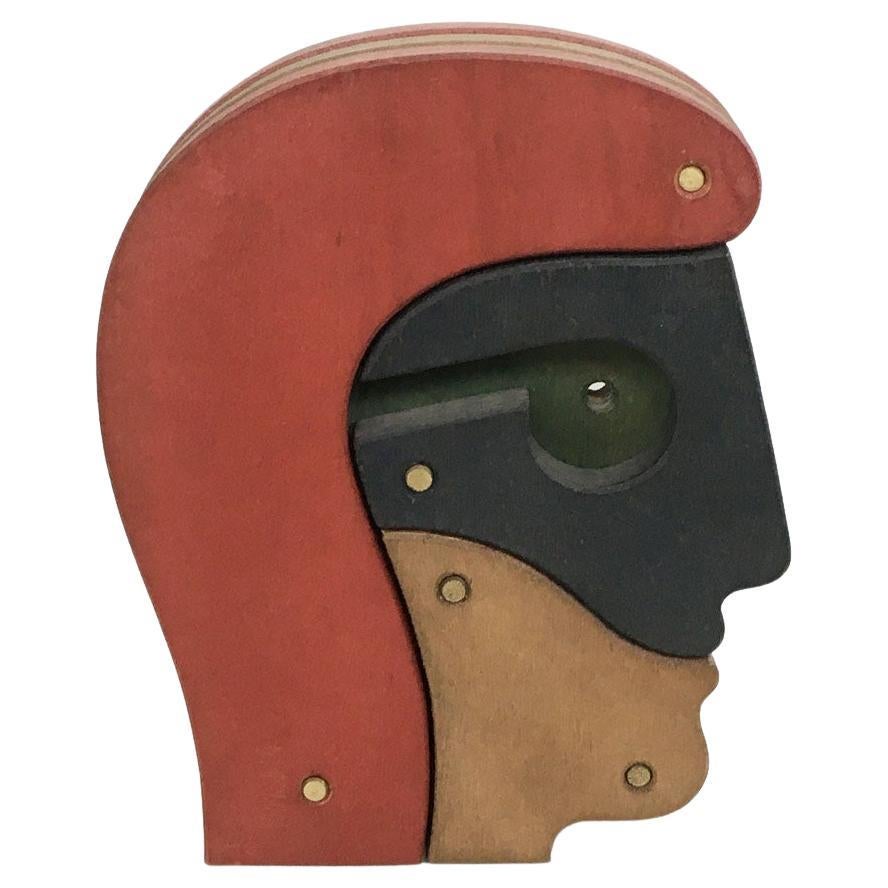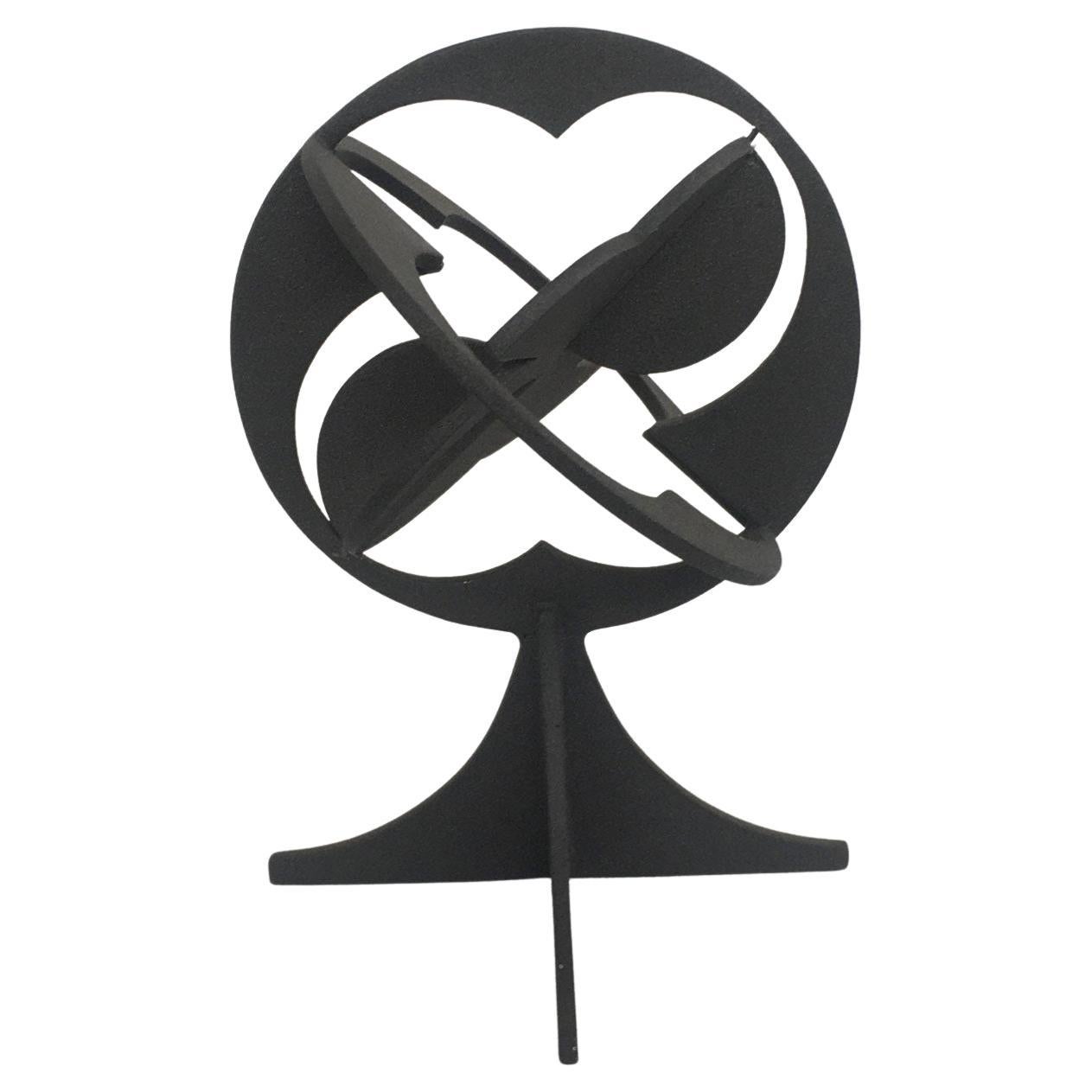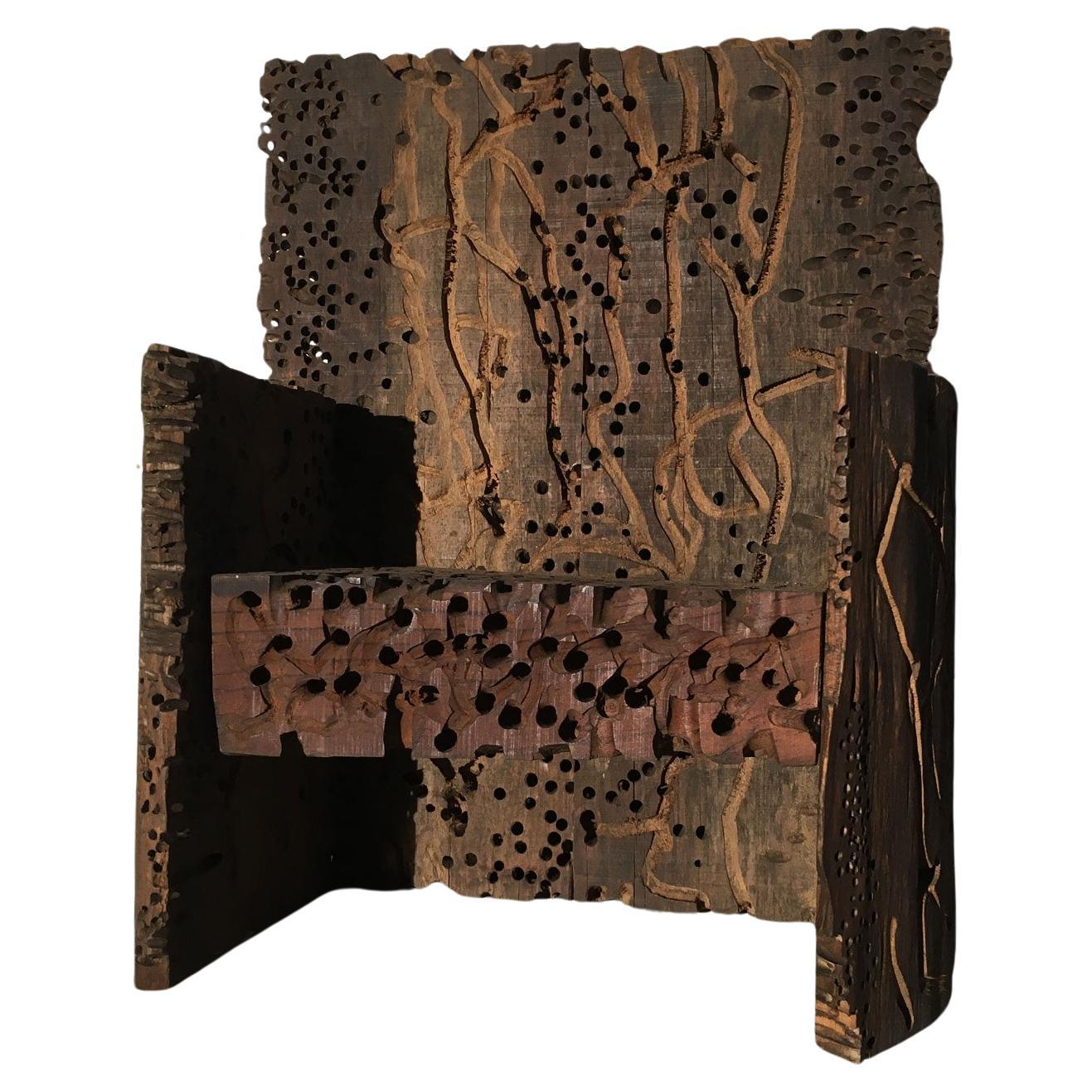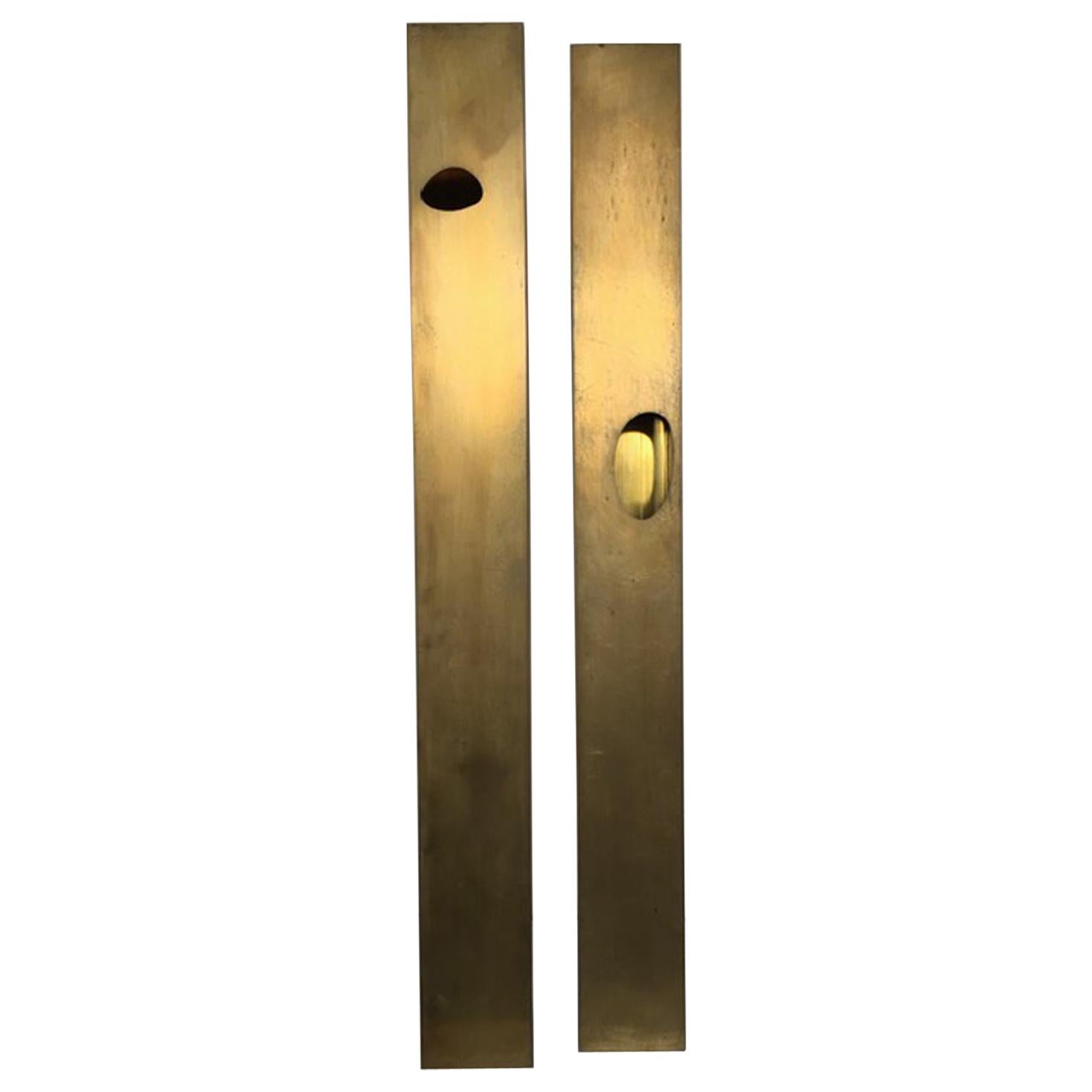Items Similar to 1975 Italy Abstract Wooden Sculpture by Nato Frascà Il Volume The Book
Want more images or videos?
Request additional images or videos from the seller
1 of 21
1975 Italy Abstract Wooden Sculpture by Nato Frascà Il Volume The Book
About the Item
This intense and engaging artwork was created by the Italian artist Nato Frascà.
The title is "Il Volume" translated in " The Book".
This is a multiple of 50 specimens and this piece was made in wood with golden letters. It is the number 43.
To better understand the meaning of this artwork it need to understand the object of study of Gruppo Uno, the pool of well known Italian artists composed by Nato Frascà, Gaetano Biggi, and others.
Nato Frascà was born in Rome, Italy, in 1931. In 1962 was one of the founders of the "Gruppo Uno", an artist group that was exploring new relationship artists and human society, by using new materials on innovative geometrical structures shapes. Gruppo Uno, terminated in 1967 and every artist began a single experience. Nato Frascà, after a first informal fase, he begin to go in the direction of the experimental of the painting spaces, spaces in which he inserted minimalistic geometrical shapes. He spent a lot of time experimenting film productions.
The artwork will be delivered with its Certificate of Authenticity numbered and signed by the artist.
- Creator:Nato Frascà (Artist)
- Dimensions:Height: 10.24 in (26 cm)Width: 10.24 in (26 cm)Depth: 1.19 in (3 cm)
- Style:Post-Modern (Of the Period)
- Materials and Techniques:
- Place of Origin:
- Period:
- Date of Manufacture:1975
- Condition:
- Seller Location:Brescia, IT
- Reference Number:1stDibs: LU3662133845092
About the Seller
5.0
Gold Seller
These expertly vetted sellers are highly rated and consistently exceed customer expectations.
Established in 2002
1stDibs seller since 2018
179 sales on 1stDibs
Typical response time: <1 hour
Associations
International Confederation of Art and Antique Dealers' Associations
- ShippingRetrieving quote...Ships From: Brescia, Italy
- Return PolicyA return for this item may be initiated within 1 day of delivery.
More From This SellerView All
- 1980 Italy Kinetic Wooden Abstract Sculpture by Bruno ChersiclaLocated in Brescia, ITThis sculpture is one of a kind piece, no other one exists and it was realized in 1980 by the well known Italian artist Bruno Chersicla. This is a kinetic abstract sculpture, most o...Category
Late 20th Century Italian Post-Modern Abstract Sculptures
MaterialsWood
- 1985 Wooden Abstract Sculpture by Urano Palma Sedia The ChairsBy Urano PalmaLocated in Brescia, ITThis very intense and engaging artwork was created by Urano Palma that is a well known Italian artist who starts to create his artworks following the philosophy of Lucio Fontana. He ...Category
Late 20th Century Italian Post-Modern Abstract Sculptures
MaterialsWood
- 1980 Italy Black Laquered Pewter Abstract Sculpture Roberto Vecchione Il MondoBy Roberto Vecchione 1Located in Brescia, ITThis interesting piece is an artwork made by the Italian artist Roberto Vecchione.This is a multiple of 1000 specimen, signed by the artist and numbered made in the 80' and stocked ...Category
Late 20th Century Italian Post-Modern Abstract Sculptures
MaterialsPewter
- 1985 Italy Wooden Abstract Sculpture by Urano Palma Grande Trono Big ThroneBy Urano PalmaLocated in Brescia, ITThis very intense and engaging artwork was created by Urano Palma that is a well known Italian artist who starts to create his artworks following the philosophy of Lucio Fontana. He ...Category
Late 20th Century Italian Post-Modern Abstract Sculptures
MaterialsWood
- 1977 Italy Wooden Abstract Sculpture by Urano Palma Non Dialogo No WordsBy Urano PalmaLocated in Brescia, ITThis very intense and engaging artwork was created by Urano Palma that is a well known Italian artist who starts to create his artworks following the philosophy of Lucio Fontana. He ...Category
Mid-20th Century Italian Post-Modern Abstract Sculptures
MaterialsWood
- Italy 1998 the Skyscrapers Brass Abstract SculptureBy Roberto Vecchione 1Located in Brescia, ITThis is an artwork of Roberto Vecchione, an Italian artist friend of Giovanni Campus and Bruno Munari. Its work is a form of ‘mind architecture’ and this two pieces are representativ...Category
1990s Italian Post-Modern Abstract Sculptures
MaterialsBrass
You May Also Like
- "Il narratore" by Enzio Wenk, 2020, Pink Wooden Sculpture, Neo-ExpressionismBy Enzio WenkLocated in Bresso, LombardyTranslated title: "The narrator". Enamel, wood, charcoal and gauze. Measures: Width 41 cm Depth 24 cm Height 93 cm.Category
2010s Italian Abstract Sculptures
MaterialsEnamel
- Italian Wooden XXL Sculpture by Gianni Pinna, 1981By Gianni PinnaLocated in Weesp, NL"Experience the beauty and craftsmanship of Gianni Pinna's stunning wooden sculpture, Documento No.7. This one-of-a-kind piece was created in Italy in 198...Category
Vintage 1980s Italian Post-Modern Abstract Sculptures
MaterialsHardwood, Paint
- Claude Viseux, Abstract Sculpture, 1975, SteelBy Claude ViseuxLocated in SAINT-SEVER, FRClaude Viseux est un peintre, sculpteur et graveur aquafortiste et lithographe français né le 3 juillet 1927 à Champagne-sur-Oise et mort le 9 novembre 2008 à Anglet. 'est dans les années 1959-1960 que la sculpture de Claude Viseux, qualifiée de « protéiforme, onirique, fantastique » — ami de Max Ernst, Man Ray, Francis Ponge et Henri Michaux, il ne désavoue pas une parenté avec le Surréalisme9 — se substitue à la peinture, ses premières réalisations étant les objets trouvés en bord de mer qu'il pétrifie dans la cire10 d'une part, les empreintes de pierres et d'algues coulées en bronze d'autre part. En 1960, il signe le Manifeste des 121 titré « Déclaration sur le droit à l’insoumission dans la guerre d’Algérie ». En 1961, ses expérimentations s'orientent vers les corps organiques, notamment avec sa série Ostéales constituée d'assemblages d'os fossilisés qu'il patine ou au contraire décape, qu'il visse, scie, assemble et plastifie. Les Concrétudes ou Coulées directes qui suivent en 1961-1962 sont obtenues à partir de coulées de métal en fusion dans le sable, générant des reliefs qu'il soude sur des plaques d'acier. Il va cependant adopter rapidement l'acier inoxydable — qu'il est avec Pol Bury parmi les premiers à employer en sculpture — comme matériau de prédilection. « Il assemble divers rebus industriels — tuyaux, écrous, boulons, cuves… — pour créer des sculptures à mi-chemin du mécanique et du biologique » restitue ainsi Sophie Serra11. Claude Viseux, qui fréquente alors Jean Tinguely, Piotr Kowalski, Michel Guino, Takis et César, confirme : « Ma récupération de l'élément industriel s'élargit vers les aciers spéciaux, avec un essai de vocabulaire formel : des barres, des profilés, des sphères, des rotules, des fonds de cuves, des chambres à combustion de Boeing, des tubulures, des soupapes de navire »9. « L'artiste entre au cœur de la réalité industrielle, prospecte dans les chaînes de montage de Renault et rôde dans les terrains vaques autour des usines », restitue donc l'encyclopédie Les Muses : « il récupère ferrailles, pièces détachées, débris de voitures, vieux châssis, toute une série d'éléments devenus inutiles. Ils les assemblent, tels quels, sans les modifier. Des créatures agressives ou pathétiques vont surgir de ce combat physique et dialectique que l'artiste livre avec la matière et entrer dans le domaine d'une poétique étrange, surnaturelle5 ». Dans les années 1967-1970, Les « structures actives » en acier inoxydable procèdent ainsi de la production industrielle de série. Elles se répartissent en familles de formes combinatoires composées par addition, soustraction, multiplication, division. Il confirme : « le monde industriel est ma nature, mon bouillon de culture, où je cherche des corps, des familles de corps, des genres, des espèces, dans un aller-retour de l'artificiel au naturel pour confondre les règnes, pour en inventer d'autres selon une géométrie organique qui féconde les différents types de structures, qui aménage la forme concernée par la forme à venir »9. En 1968, Claude Viseux s'installe à la villa Baudran à Arcueil, atelier qu'il conservera jusqu'en 1992. Si des corps imaginaires naissent ainsi des pièces mécaniques que Claude Viseux emprunte à l'automobile, à l'avion et au bateau, en 1972, « la symétrie de ces formes pures en inox », constate Lydia Harambourg, « l'amène à s'interroger sur la notion d'équilibre instable »12. Ses Instables sont de la sorte exposés à la Biennale de Venise en 1972 où, rappelle encore Lydia Harambourg, une salle entière est consacrée « aux dessins qui reprennent son vocabulaire mécanique identitaire de sphères, toupies, hélices, anneaux, astrolabes et balanciers »12. Les Instables sont de même, en 1973, présentés à la galerie Le Point cardinal à Paris où Claude Viseux avait déjà exposé en 1968 avec Henri Michaux et Joaquin Ferrer...Category
Vintage 1970s French Abstract Sculptures
MaterialsBronze, Steel
- Signed Girevole Sculpture by Pietro Consagra, Italy, 1975By Pietro ConsagraLocated in Roma, ITThis sculpture is signed Consagra, who was a very prolific and renowned international Italian sculptor; no longer living. Sculptor, he began his career by joining the Forma 1 Grou...Category
Vintage 1970s Italian Abstract Sculptures
MaterialsIron, Stainless Steel
- Wooden Abstract Sculpture by Juan Jose VeraLocated in Saint-Ouen, FRWooden painted sculpture by the Spanish Artist Juan Jose Vera Signed Juan Jose Vera -Los pajaros-“the Birbs” 1984.Category
Vintage 1980s Spanish Modern Abstract Sculptures
MaterialsWood
- Abstract Wooden Sculpture by Hanneke Mols, 1960sLocated in Rotterdam, NLAbstract wooden Sculpture by Hanneke Mols van Gool (1933 - 2020), The Netherlands 1960s. Hanneke Mols studied at the academy of arts in Tilburg (1950-1952), the Jan van Eyck Academy in Maastricht (1952-1955) which she left to achieve more experience and a wider state of mind at the Accademia di Belle Arti di Brera e Liceo Artistico in Milan. She was a study of internationally well known names such as Oscar Jespers...Category
Vintage 1960s European Mid-Century Modern Abstract Sculptures
MaterialsOak
Recently Viewed
View AllMore Ways To Browse
Lucio Fontana Black Egg
Michael Atkinson
Nadine Saylor
Patrick Horsley
Ph150 Excellence
Picasso Flamingo
Stanley Stangren
Tiffany Jewelry Las Vegas
Vintage Fritz Van Daalen
Aad Verboom
Abigail Varela
Adrian Fernandez
Aida Tomiyasu
Annemie Fontana
Archipenko Alexander Porfyrovych
Bouchon Chandelier
Cecilia Miguez
Chase Art Deco Period Tubular Chrome Sculpture





